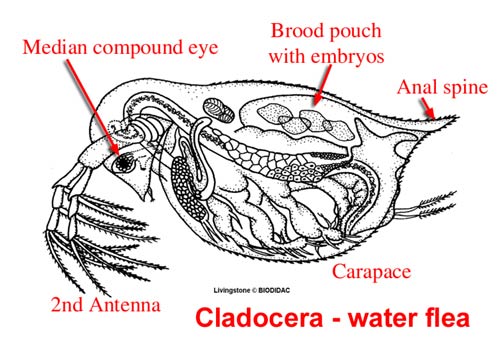| |
- Cladocera
Common names:
water fleas, daphnia
Probability of
encounter: high if intercept has standing water and from some
soils if appropriate extraction techniques used (i.e. wet funnel, flotation).
Quarantine importance:
unknown. Most species are suspension feeders on detritus and microbes.
Similarity to mites:
small size, lack of clear segmentation
- Morphology
Normal adult length:
mostly 0.25 - 2 mm
Body tagmata: head (1 pair of antennae), trunk, postabdomen
Eyes: median fused compound eye, naupliar eye
Antennae: biramous, swimming
Mouthparts: mandibles without palps; one pair of maxillae
Legs: 5-6 pairs of swimming/ grasping/ filtering legs
Respiration: cutaneous and coxal epipodites of trunk limbs
Gonopore: various on trunk
Distinguishing features: Minute swimming crustaceans with head shield
and shell-like carapace, swimming 2nd antennae, dorsal brood chamber
Comments: Water
fleas
are normally considered aquatic organisms and would be expected primarily in
moist
intercepts (e.g. bromeliads); however, they also can be extracted with wet
funnels from some soils. Eggs are brooded under the carapace which
sometimes forms a protective capsule (ephippium) that allows aerial dispersal by
wind.
Diversity:
4 suborders, 11 families, 80+ genera, >400 species.
References
The Cladoceran Website -
http://www.cladocera.uoguelph.ca/
